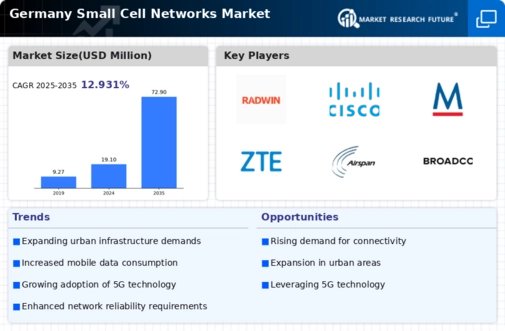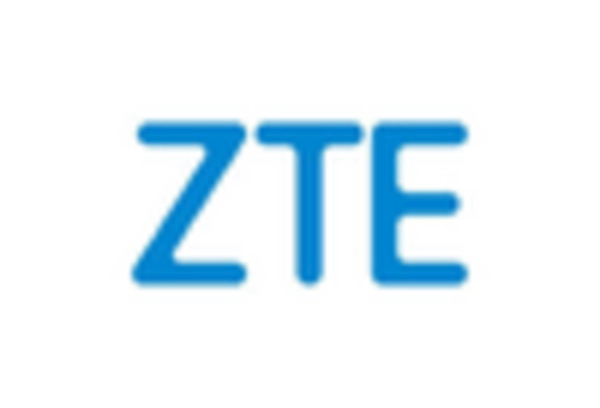Growing Adoption of IoT Applications
The small cell-networks market in Germany is significantly influenced by the growing adoption of Internet of Things (IoT) applications. As industries increasingly integrate IoT devices into their operations, the demand for reliable and high-capacity networks becomes paramount. Small cells are well-suited to support the connectivity needs of IoT applications, which often require low latency and high reliability. The small cell-networks market is thus positioned to capitalize on this trend, as businesses seek to implement IoT solutions that enhance efficiency and productivity. Recent studies suggest that the number of connected IoT devices in Germany is expected to reach 1 billion by 2026, further emphasizing the need for robust small cell infrastructure to support this growth. Consequently, the market is likely to see increased investments in small cell technology to accommodate the expanding IoT ecosystem.
Rising Demand for Enhanced Connectivity
The small cell-networks market in Germany is experiencing a notable surge in demand for enhanced connectivity solutions. As urban areas become increasingly populated, the need for reliable and high-speed internet access intensifies. This demand is driven by the proliferation of smart devices and the growing reliance on mobile applications. According to recent data, approximately 80% of mobile data traffic is generated indoors, highlighting the necessity for small cell deployments in urban environments. The small cell-networks market is thus positioned to address these connectivity challenges, providing solutions that enhance user experience and support the increasing data consumption. Furthermore, the integration of small cells into existing infrastructure is expected to facilitate seamless connectivity, thereby driving market growth in the coming years.
Regulatory Support for Network Expansion
Regulatory support is emerging as a crucial driver for the small cell-networks market in Germany. The government is actively promoting the expansion of telecommunications infrastructure to ensure widespread access to high-speed internet. This regulatory environment encourages operators to invest in small cell deployments, particularly in underserved areas. The small cell-networks market benefits from initiatives aimed at streamlining the approval process for small cell installations, thereby reducing barriers to entry. Additionally, government policies that incentivize infrastructure development are likely to stimulate market growth. As a result, the small cell-networks market is expected to flourish in an environment that fosters innovation and supports the expansion of network capabilities, ultimately enhancing connectivity for consumers and businesses alike.
Increased Focus on Indoor Coverage Solutions
The small cell-networks market in Germany is witnessing an increased focus on indoor coverage solutions. With a substantial portion of mobile data being consumed indoors, businesses and service providers are prioritizing the deployment of small cells to enhance indoor connectivity. This trend is particularly evident in commercial buildings, shopping centers, and public venues, where reliable internet access is crucial for customer satisfaction. The small cell-networks market is responding to this demand by offering tailored solutions that address specific indoor coverage challenges. Furthermore, as organizations recognize the importance of robust connectivity for operational efficiency, investments in small cell technology are expected to rise. This shift towards indoor solutions is likely to drive market growth, as stakeholders seek to improve user experiences and optimize network performance.
Technological Advancements in Network Infrastructure
Technological advancements play a pivotal role in shaping the small cell-networks market in Germany. Innovations in network infrastructure, such as the development of 5G technology, are propelling the adoption of small cells. These advancements enable operators to enhance network capacity and coverage, particularly in densely populated areas. The small cell-networks market is likely to benefit from the ongoing evolution of wireless technologies, which are designed to support higher data rates and lower latency. As a result, operators are increasingly investing in small cell solutions to meet the demands of modern consumers. Reports indicate that the market for small cell equipment is projected to grow at a CAGR of 25% over the next five years, underscoring the significance of technological progress in driving market expansion.

















Leave a Comment